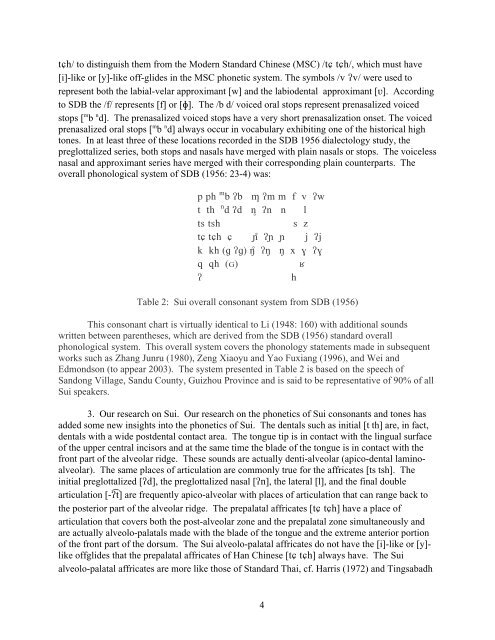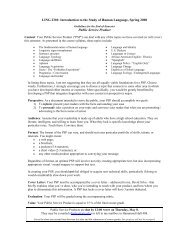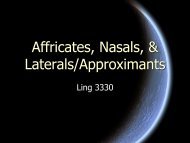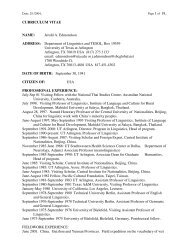1 A phonetic study of the Sui consonants and tones Jerold A ...
1 A phonetic study of the Sui consonants and tones Jerold A ...
1 A phonetic study of the Sui consonants and tones Jerold A ...
You also want an ePaper? Increase the reach of your titles
YUMPU automatically turns print PDFs into web optimized ePapers that Google loves.
t�h/ to distinguish <strong>the</strong>m from <strong>the</strong> Modern St<strong>and</strong>ard Chinese (MSC) /t� t�h/, which must have<br />
[i]-like or [y]-like <strong>of</strong>f-glides in <strong>the</strong> MSC <strong>phonetic</strong> system. The symbols /v �v/ were used to<br />
represent both <strong>the</strong> labial-velar approximant [w] <strong>and</strong> <strong>the</strong> labiodental approximant [�]. According<br />
to SDB <strong>the</strong> /f/ represents [f] or [�]. The /b d/ voiced oral stops represent prenasalized voiced<br />
stops [ m b n d]. The prenasalized voiced stops have a very short prenasalization onset. The voiced<br />
prenasalized oral stops [ m b n d] always occur in vocabulary exhibiting one <strong>of</strong> <strong>the</strong> historical high<br />
<strong>tones</strong>. In at least three <strong>of</strong> <strong>the</strong>se locations recorded in <strong>the</strong> SDB 1956 dialectology <strong>study</strong>, <strong>the</strong><br />
preglottalized series, both stops <strong>and</strong> nasals have merged with plain nasals or stops. The voiceless<br />
nasal <strong>and</strong> approximant series have merged with <strong>the</strong>ir corresponding plain counterparts. The<br />
overall phonological system <strong>of</strong> SDB (1956: 23-4) was:<br />
p ph m b �b m� �m m f v �w<br />
t th n d �d n� �n n l<br />
ts tsh s z<br />
t� t�h � �� �� � j �j<br />
k kh (� ��) �� �� � x � ��<br />
q qh (�) �<br />
� h<br />
Table 2: <strong>Sui</strong> overall consonant system from SDB (1956)<br />
This consonant chart is virtually identical to Li (1948: 160) with additional sounds<br />
written between paren<strong>the</strong>ses, which are derived from <strong>the</strong> SDB (1956) st<strong>and</strong>ard overall<br />
phonological system. This overall system covers <strong>the</strong> phonology statements made in subsequent<br />
works such as Zhang Junru (1980), Zeng Xiaoyu <strong>and</strong> Yao Fuxiang (1996), <strong>and</strong> Wei <strong>and</strong><br />
Edmondson (to appear 2003). The system presented in Table 2 is based on <strong>the</strong> speech <strong>of</strong><br />
S<strong>and</strong>ong Village, S<strong>and</strong>u County, Guizhou Province <strong>and</strong> is said to be representative <strong>of</strong> 90% <strong>of</strong> all<br />
<strong>Sui</strong> speakers.<br />
3. Our research on <strong>Sui</strong>. Our research on <strong>the</strong> <strong>phonetic</strong>s <strong>of</strong> <strong>Sui</strong> <strong>consonants</strong> <strong>and</strong> <strong>tones</strong> has<br />
added some new insights into <strong>the</strong> <strong>phonetic</strong>s <strong>of</strong> <strong>Sui</strong>. The dentals such as initial [t th] are, in fact,<br />
dentals with a wide postdental contact area. The tongue tip is in contact with <strong>the</strong> lingual surface<br />
<strong>of</strong> <strong>the</strong> upper central incisors <strong>and</strong> at <strong>the</strong> same time <strong>the</strong> blade <strong>of</strong> <strong>the</strong> tongue is in contact with <strong>the</strong><br />
front part <strong>of</strong> <strong>the</strong> alveolar ridge. These sounds are actually denti-alveolar (apico-dental laminoalveolar).<br />
The same places <strong>of</strong> articulation are commonly true for <strong>the</strong> affricates [ts tsh]. The<br />
initial preglottalized [�d], <strong>the</strong> preglottalized nasal [�n], <strong>the</strong> lateral [l], <strong>and</strong> <strong>the</strong> final double<br />
articulation [-��t] are frequently apico-alveolar with places <strong>of</strong> articulation that can range back to<br />
<strong>the</strong> posterior part <strong>of</strong> <strong>the</strong> alveolar ridge. The prepalatal affricates [t� t�h] have a place <strong>of</strong><br />
articulation that covers both <strong>the</strong> post-alveolar zone <strong>and</strong> <strong>the</strong> prepalatal zone simultaneously <strong>and</strong><br />
are actually alveolo-palatals made with <strong>the</strong> blade <strong>of</strong> <strong>the</strong> tongue <strong>and</strong> <strong>the</strong> extreme anterior portion<br />
<strong>of</strong> <strong>the</strong> front part <strong>of</strong> <strong>the</strong> dorsum. The <strong>Sui</strong> alveolo-palatal affricates do not have <strong>the</strong> [i]-like or [y]like<br />
<strong>of</strong>fglides that <strong>the</strong> prepalatal affricates <strong>of</strong> Han Chinese [t� t�h] always have. The <strong>Sui</strong><br />
alveolo-palatal affricates are more like those <strong>of</strong> St<strong>and</strong>ard Thai, cf. Harris (1972) <strong>and</strong> Tingsabadh<br />
4





